Let's Explore: The Colonial Era in India | Social Science Class 8 - New NCERT PDF Download
Page 87: LET’S EXPLORE
Q. What do you think the cartoon (Fig. 4.3) is trying to express? (Keep in mind that the telegraph, which permitted instant communications for the first time, was then a recent invention.) Analyse different elements of the drawing.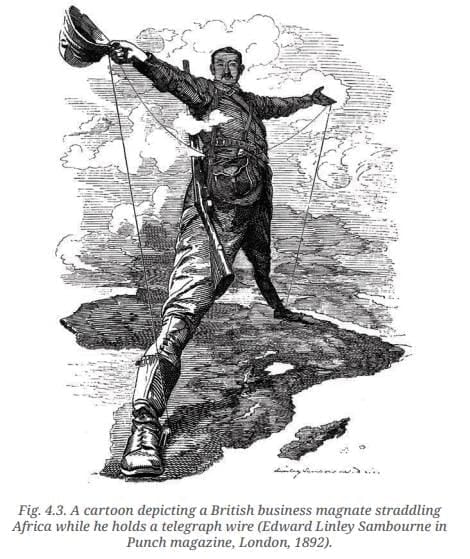
Ans:
- I think the cartoon is showing how the British used the telegraph to control faraway places like Africa and India! The telegraph, being new, let them send orders quickly, making their rule stronger.
- I imagine it shows a British businessman standing over Africa with telegraph wires stretching out, looking powerful and greedy. The wires might look like traps, showing how communication helped them dominate.
- The man’s big size compared to others could mean he thinks he’s better, and Africa might look helpless. This makes me feel it’s about how technology gave the British unfair power over others!
Page 92: LET’S EXPLORE
Q. Before you read further, have a good look at the painting on the first page of this chapter. It was specially ordered for the London headquarters of the East India Company and is over three metres long. Observe every aspect of it — the people in it, the objects, the symbols and the attitudes. Form groups of four or five students and let each group present its conclusions as regards the messages the painting conveys.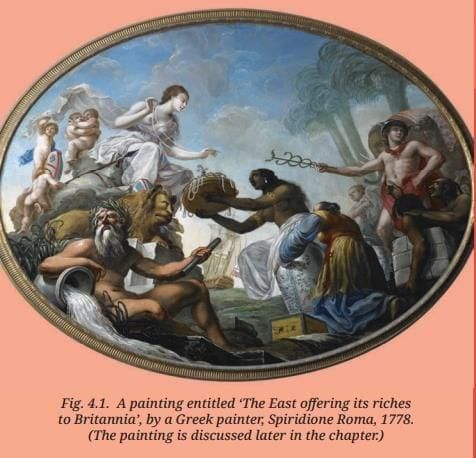 Ans: Looking at the painting (Fig. 4.1), I see Britannia, a lady for Britain, sitting high up with a lion, showing power, while people from the East, maybe Indians, offer her riches like pearls and jewels.
Ans: Looking at the painting (Fig. 4.1), I see Britannia, a lady for Britain, sitting high up with a lion, showing power, while people from the East, maybe Indians, offer her riches like pearls and jewels.
- The objects, like ships or cotton bales, show trade, and the bent posture of the Eastern figures feels like they’re forced to give up their wealth. The attitude seems proud for Britannia but sad for the others.
- I’d tell my group this painting brags about Britain taking India’s riches by force, not as a gift, and we could discuss how it hides the real struggle!
Page 98: LET’S EXPLORE
Q. Why do you think Dadabhai Naoroji means by ‘un-British rule in India’? (Hint: he was an MP in the House of Commons in 1892.)
- I think Dadabhai Naoroji meant ‘un-British rule’ because the way Britain ruled India didn’t match their own values of fairness and justice, which they talked about back home. As an MP in 1892, he saw Britain’s promise of good governance but saw India suffering from plunder and famines instead.
- He probably felt this rule was cruel and not what a British leader should do, especially since he worked to show how wealth was drained from India. I’d discuss with friends how this shows he wanted Britain to be better!
Page 98: THINK ABOUT IT
Q. Let us return to this painting (Fig. 4.14), but now with some clues to its symbolism. Note how Britannia (a symbolic figure for Britain) sits higher than the colonies, pointing to her superior power; contrast with the lower position and bent posture of the colonies. Did they really ‘offer’ their wealth? Or did Britain seize it by force or ruse? Note also the Indians’ dark complexion (in contrast with that of Britannia), reflecting the belief in the superiority of white people over the dark-skinned ‘natives’.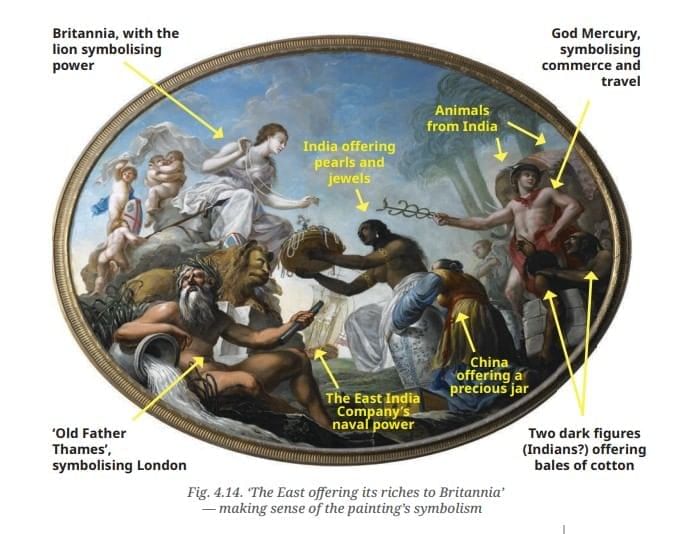
- I think the painting shows Britannia looking powerful up high with a lion, while the colonies, like India, are bent low with riches, which doesn’t feel like a real offer—it looks forced!
- Britain probably seized the wealth by fighting or tricking people, like in the Battle of Plassey. The dark skin of Indians versus Britannia’s light skin makes it seem like the British thought they were better, which is unfair.
- I’d tell my friends this painting hides the truth of exploitation behind a pretty picture!
Page 100: LET’S EXPLORE
Q. Do you understand all the terms used above to list and describe Indian textiles? If not, form groups of four or five and try to find out more, then compare your findings with the help of your teacher.
- I know some terms like cotton and silk, which are soft fabrics, but I’m not sure about jute, hemp, or coir. Jute might be a rough fiber for bags, hemp could be a strong plant fiber, and coir sounds like coconut husk fiber for ropes.
- Embossed fabrics with raised designs sound fancy! I’d join a group to look up these in books or ask our teacher, then share that cotton was India’s pride, while jute and coir were used for tough goods, showing India’s skill before British rule hurt it!
Page 102: THINK ABOUT IT
Q. What exactly did Macaulay mean when he wrote that “a single shelf of a good European library was worth the whole native literature of India and Arabia”? And why should he want to make Indians “English in taste, in opinions, in morals, and in intellect”? How does this relate to the ‘civilising mission’ mentioned at the start of the chapter? Ask your teacher to guide a class debate on these questions.
- I think Macaulay meant European books were more valuable than India’s or Arabia’s old writings, even though he didn’t know their languages— that feels arrogant!
- He wanted Indians to think and act like English people to serve British rule better, like clerks. This ties to the ‘civilizing mission’ because he thought India needed to be ‘improved’ with British ways, not respected for its own culture. I’d love a debate with my teacher to argue if his ideas were right or just a way to control us!
Page 104: THINK ABOUT IT
What is meant by “the sun never sets on the British Empire”? Do you think this was a correct statement?
- “The sun never sets” means the British Empire was so huge, covering places like India, Africa, and America, that it was always daytime somewhere they ruled. I think it was true back then because their colonies were all over the world!
- But it also sounds proud, like they’d rule forever, which wasn’t right since India and others fought back and got free. I’d ask my friends if they think it was more about power or just geography!
Page 105: LET’S EXPLORE
Examine the map. What are the main differences with the map of today’s India, in terms both of borders and of names?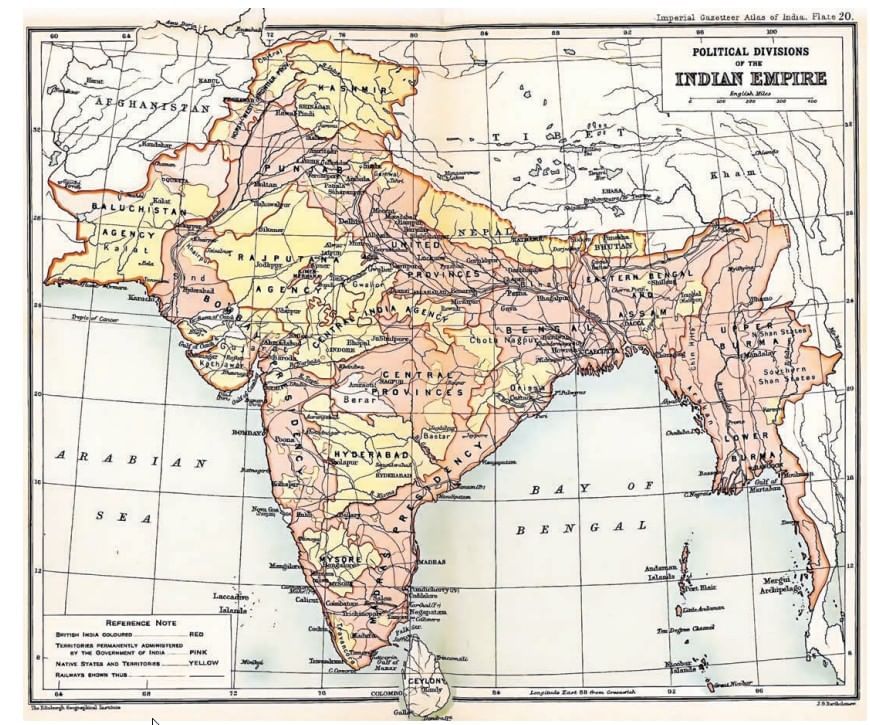 Map of British Indian Empire in 1909
Map of British Indian Empire in 1909
- Looking at the 1909 map, I see red and pink areas under British rule and yellow princely states, which are different from today’s India. The borders include places like Burma (now Myanmar) and parts of Pakistan and Bangladesh, which aren’t with India now after 1947.
- Names like Bombay (now Mumbai) and Madras (now Chennai) have changed, and some princely states like Hyderabad are gone as separate areas. I’d compare this with a modern map to see how India’s shape and names evolved after independence!
Page 107: LET’S EXPLORE
Note how the Santhals are depicted in the 1856 sketch (Fig. 4.17) drawn from an artist’s imagination: observe their complexion, dress, weapons and draw your conclusions as regards the image this depiction would create in the popular mind in Britain.
- In the sketch, the Santhals look dark-skinned, wearing simple clothes like loincloths, and holding basic weapons like bows and arrows. This makes them seem wild or weak compared to the British sepoys with guns.
- I think this picture would make people in Britain think Santhals were primitive and easy to beat, not brave fighters. It feels like the artist wanted to show British power and make the Santhals look less human, which isn’t fair since they fought hard!
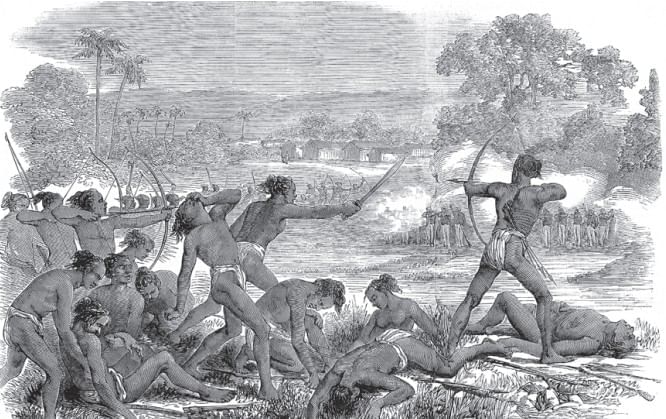
Page 108: LET’S EXPLORE
Q1. Indigo is a natural deep blue pigment used in dyeing. Can you think of other natural substances that have been traditionally used in India to dye cloth?
- Indigo sounds cool for blue dye! I think other natural dyes in India include turmeric for yellow, which comes from a root we use in food, and henna for reddish-brown, used for hands.
- Madder root gives red, and tea leaves can make brown. I’d ask my friends if they know more, like how these were used before British forced indigo, showing India’s old dyeing skills!
Q2. Why do you think was the term ‘Sepoy Mutiny’ rejected after Indian Independence? Write one paragraph explaining your reasons.
- I think the term ‘Sepoy Mutiny’ was rejected after Independence because it made the 1857 uprising sound like just a soldier’s rebellion, which feels too small and ignores the big fight for freedom by many Indians.
- Calling it a ‘mutiny’ also suggests it was wrong, but for Indians, it was a brave stand against British rule, led by heroes like Rani Lakshmibai. After 1947, we wanted a name like ‘Great Rebellion’ to honor everyone who fought, not just sepoys, and to show it was a step toward independence, not a mistake!
Page 112: LET’S EXPLORE
Q1. In the sentence “It opened (or re-opened) India to the world and the world to India”, why do you think we added ‘re-opened’?
- I think ‘re-opened’ was added because India already traded with the world long ago, like with the Greeks and Romans, before the British came.
- The British didn’t start this connection; they just brought it back with their rule, but in a different way by taking control. ‘Re-opened’ shows it was a return to old links, not a new one, and I’d discuss with my group how this trade was different under colonialism!
Q2. Some argue that stolen cultural heritage has been better preserved abroad than it would have been in India. What is your view on its repatriation? Discuss in groups.
- I think stolen items like statues should come back to India because they’re part of our history and belong with us, not in foreign museums. Even if they’re preserved better abroad, it feels wrong that they were taken by force.
- I’d tell my group that having them here would help us learn and feel proud, and we could protect them now. Maybe we could agree some should stay abroad for study, but most should return to show respect for India’s past!
|
31 videos|128 docs|7 tests
|
FAQs on Let's Explore: The Colonial Era in India - Social Science Class 8 - New NCERT
| 1. What were the main reasons for the British colonization of India? |  |
| 2. How did the British implement their rule in India? |  |
| 3. What impact did British colonial rule have on Indian society and culture? |  |
| 4. What were the major uprisings against British rule in India? |  |
| 5. How did the colonial era in India contribute to the independence movement? |  |





















